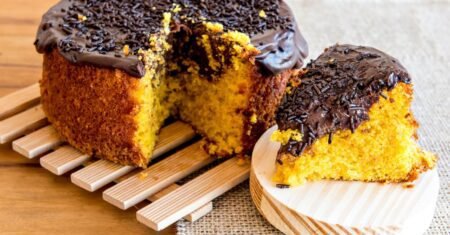Lactose-free milk pudding

Lactose-free milk pudding, if you’re lactose intolerant and love pudding! Here’s a delicious, practical and healthy recipe.

What you’ll need for the recipe, let’s get to the ingredients.
Ingredients for the syrup
Half a cup of demerara sugar.
-----------------------------Continua depois do anúncio---------------------------
Half a cup of hot water.
Ingredients for the pudding
1 cup zero lactose powdered milk
-----------------------------Continua depois do anúncio---------------------------
2 cups water
half a cup of demerara sugar
1 tablespoon vegetable cream
2 tablespoons zero lactose powdered milk.
3 eggs
1 teaspoon vanilla essence.
Directions
Syrup
Melt the demerara sugar in a saucepan until golden brown. Add the hot water and stir with a spoon.
Bring to the boil until the sugar dissolves and the syrup thickens. Place the syrup lining the bottom of an 18-centimeter (7-inch) diameter baking pan and set aside.
Pudding🍮
In a blender, blend 1 cup of hot water, the demerara sugar and the vegetable cream until the mixture is smooth. Refrigerate for about 15 minutes.
Put the mixture back into the blender, add two tablespoons dissolved in a cup of water, the eggs and vanilla essence and blend. Pour the mixture into the reserved tin.
Then cover with baking paper and bake in a medium oven (180 °C), in a bain-marie with hot water, for about an hour and thirty minutes or until you poke a knife in and it comes out clean.
Once cool, refrigerate for a couple of hours or so.
Translated with DeepL.com (free version)
Serves 12 👨👩👧👦 = Easy difficulty🥣 = Preparation time 220 minutes⏰
Nutritional value per serving (approximately 1/6 of the recipe)
Calories: Around 176 kcal
Total fat: About 6g
Saturated fats: Around 2g
Carbohydrates: About 23g
Sugars: Around 21g
Proteins: About 7g
Dietary fiber: About 0g
Sodium: Around 108mg
These figures are rough estimates and may vary depending on factors such as the specific brand of ingredients used and variations in the exact quantities of each ingredient in the recipe.

The delicious story behind milk pudding
Imagine a dessert so divine that it transcends borders and is loved the world over. We’re talking about milk pudding, a delicacy that has delighted palates for centuries.
But where does this creamy, comforting delight come from? The history of milk pudding goes back to antiquity, with roots stretching across different cultures and civilizations.
However, some historians believe that its origins can be traced back as far as Ancient Rome, where the Romans prepared a similar dessert called “sagan” or “saganaki”.
However, it was during the expansion of the Roman Empire that milk pudding began to gain popularity throughout Europe. The Arabs, skilled in the art of cooking, improved the recipe by adding ingredients such as sugar, pistachios and rose water, giving it an exotic and refined touch.
Over the centuries, milk pudding crossed oceans and continents, adapting to local tastes and winning hearts wherever it went. In Brazil, for example, pudim de leite has become an iconic dessert, present at practically every family celebration and renowned restaurant.
Today, milk pudding is celebrated as a world confectionery classic, with countless variations and creative interpretations in every corner of the globe. Whether in the traditional version, with an irresistible caramelized syrup, or in new lactose-free, vegan or exotic-flavoured versions, milk pudding continues to delight and unite people around the table.
So the next time you enjoy a slice of this heavenly treat, remember the rich history behind this simply irresistible dessert. Pudim de leite is not only a delight for the palate, but also a journey through time and cultures, uniting us in a sweet celebration of life.
Frequently asked questions
Can I substitute zero lactose powdered milk with almond milk or another vegetable milk?
Yes, you can make this substitution, but it may affect the texture and taste of the pudding.
Does lactose-free milk pudding taste the same as traditional pudding?
The taste may be a little different due to the absence of dairy products, but it’s still delicious. The vanilla essence helps to reinforce the flavor.
How do you get the right consistency without using ordinary milk?
Vegetable cream and eggs help give the pudding its creaminess. Make sure you follow the correct proportions and method of preparation to ensure the desired texture.
Can I make this recipe vegan?
Yes, you can replace eggs with vegan substitutes such as aquafaba (chickpea cooking water) or commercial egg substitute mixes.
How can I prevent the pudding from becoming too liquid or too hard?
Make sure you follow the proportions of ingredients and cooking time recommended in the recipe exactly. Using a bain-marie during cooking can also help ensure a smooth, creamy texture.
Can I use another type of sugar apart from demerara?
Yes, you can experiment with other types of sugar, such as brown sugar or coconut sugar. Remember that this may slightly alter the final taste of the pudding.
Is it possible to freeze lactose-free milk pudding?
Yes, you can freeze the pudding in individual portions. Make sure you pack it well to avoid ice crystals forming and defrost it completely before serving.
About the Author

0 Comments